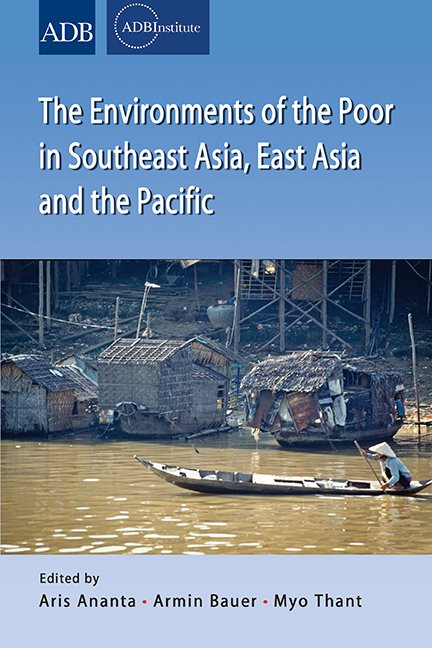Book contents
- Frontmatter
- Contents
- Preface
- List of Contributors
- Part I OVERVIEW
- Part II EAST ASIA (People's Republic of China and Republic of Korea)
- 2 Poverty, Environment, and Climate Change in the Grasslands of China
- 3 Climate Change, Food Security, and Poverty in the People's Republic of China
- 4 The Physical and Social Environment of the Chinese Urban Poor
- 5 Benefiting the Poor, the Environment, and the Private Sector with Small Enterprises and Green Jobs in the People's Republic of China
- 6 Environment, Economic Growth, and Poverty in the Republic of Korea
- Part III PACIFIC ISLANDS
- Part IV MAINLAND SOUTHEAST ASIA (Cambodia, Thailand, Vietnam)
- Part V ARCHIPELAGIC SOUTHEAST ASIA (Indonesia, Malaysia, Philippines)
4 - The Physical and Social Environment of the Chinese Urban Poor
from Part II - EAST ASIA (People's Republic of China and Republic of Korea)
Published online by Cambridge University Press: 21 October 2015
- Frontmatter
- Contents
- Preface
- List of Contributors
- Part I OVERVIEW
- Part II EAST ASIA (People's Republic of China and Republic of Korea)
- 2 Poverty, Environment, and Climate Change in the Grasslands of China
- 3 Climate Change, Food Security, and Poverty in the People's Republic of China
- 4 The Physical and Social Environment of the Chinese Urban Poor
- 5 Benefiting the Poor, the Environment, and the Private Sector with Small Enterprises and Green Jobs in the People's Republic of China
- 6 Environment, Economic Growth, and Poverty in the Republic of Korea
- Part III PACIFIC ISLANDS
- Part IV MAINLAND SOUTHEAST ASIA (Cambodia, Thailand, Vietnam)
- Part V ARCHIPELAGIC SOUTHEAST ASIA (Indonesia, Malaysia, Philippines)
Summary
Over the past thirty years, China has witnessed an explosive growth of its cities. By 2008, the urban population of China had risen to 607 million (45.7 per cent of the population). Two-thirds of the urban population growth is attributable to rural-to-urban migration. By 2015, the urban population is projected to be 700 million, exceeding the rural population for the first time. By 2030, one billion people will live in China's cities. This growth is being accompanied by a rapid expansion of urban land: between 1990 and 2005, China's urban land area grew by an average of 24,727 square kilometres per year, reaching a total of 2,600,000 square kilometres. In this essay, we examine the history of urbanization in China and explore the effects of the related spatial, physical, and social changes on the environments of the poor. In order to create sustainable urban environments in the coming years, it will be necessary to address the challenges these changes bring with them.
URBANIZATION IN CHINA
Rapid urbanization has contributed to China's economic growth and improved living conditions. From 1981 to 2001, 400 million people escaped poverty and 200 million of those who continue to live below one dollar per day have been provided with assistance. These successes have created new challenges for local authorities in urban areas. They have had to concern themselves with providing housing, improving access to services, and addressing growing inequality. “China has recorded the most spectacular progress in the world, with improvements to the day-to-day conditions of 65.3 million urban residents who were living with one or more factors of shelter deprivation.”
In 1949, China was a predominantly rural society. Only 11 per cent of the population lived in its 69 cities. 5 China's urbanization has passed through three distinct phases: moderate growth, a plateau from the late 1950s to the early 1980s, and accelerating urbanization in recent years. In the 1950s, a natural growth of urbanization took place without restrictions as people moved freely from the countryside to the cities.
- Type
- Chapter
- Information
- Publisher: ISEAS–Yusof Ishak InstitutePrint publication year: 2013



